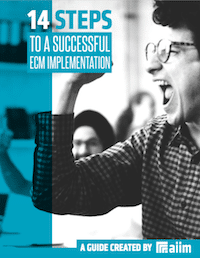The AIIM Blog
Keep your finger on the pulse of Intelligent Information Management with industry news, trends, and best practices.
I recently purchased a new car from one of the largest car dealers in the country (privately owned, $55 million in annual revenues). Given that I am notoriously cheap about cars, it was a very inexpensive car, and we paid cash. After negotiating the deal, we went to the back room where we signed all of the documentation. We signed the following forms:
Share
Capture and Imaging | Document Management | Enterprise Content Management (ECM) | Intelligent Information Management (IIM)
One of the things I talk about during my presentations is that while capture is a mature technology (i.e., it actually works as advertised), the capture market is still relatively immature. Specifically, while a relatively high percentage of user organizations are scanning to archive, relatively few are extracting data from images to doing indexing or metadata, even fewer are extracting data to drive processes, and still fewer have a true enterprise capture strategy.
Share

Making an ECM implementation successful requires planning and attention to detail. The best way to create the right solution is to identify organizational goals and priorities. Learn how to manage a successful implementation in our free guide.
Myth #1: Desktop scanning works well enough for digitizing my paper documents Reality: Digitizing your paper is really just a small piece to the solution and does provide some value, but the scope of your business problem will determine whether or not a simple desktop capture solution is going to do the job. For small organizations or businesses that are looking to do a simple back-file document conversion project, a basic capture system might satisfy their requirements. But for mid- and large-sized organizations, the requirements are often more complex and require advanced document automation, distributed capture, and connectivity with a host of business systems.
Share
Batch Transaction Capture Software is used primarily to understand and extract data from documents in order to feed back-end database applications or business process analysis. It is designed to replace manual, error-prone, and expensive document sorting and data entry processes with automatic document classification, separation, and data extraction.
Share
Document capture software is the front-end software that is used to convert unstructured and semi-structured paper or formatted electronic business documents (e.g., various PDF files or faxes), and other unstructured content-centric business documents into an indexed image and then automatically use pattern recognition technologies supplemented by business rules to extract accurate data and add pertinent metadata for use in one or more business processes.
Share
While capture vendors typically offer an array of outputs to support multiple different ECM image formats, the industry has mostly settled on three standard formats. There are pros and cons to each format. Which one you use depends on the volume, what information is being captured, and how you plan on using that information. 1. TIFF As bandwidths were limited when the imaging and document management industry began, the industry adopted 200 dots-per-inch TIFF Group 4 compressed black and white images as their standard (which created a roughly 75K KB image for a standard page of text). A secondary advantage to the TIFF group 4 format was that it is a loss-less compression standard—i.e., no image data is removed during the compression. Each vendor then added some specific headers, which made their formats unique. Third-party capture vendors, therefore, had to create “formatters” or “release scripts” in order to create an image that would seamlessly import into the document management systems.
Share